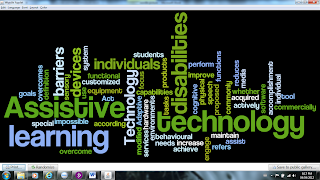When it comes to learning, every child (or person, in general) learns differently. Some people are auditory learners, some people are kinesthetic learners, but then there are those special people with learning disabilities who often struggle with learning from everyday devices. For a student who has no problem learning, using a SMARTboard may not be an issue, but what if another student is blind? Another student may have no difficulty using their iPad to play a game with their sight words, but what if a student is deaf? There are specific tools that have been designed to help these special little guys out. I know there are usually classrooms set aside for special needs children, but even in a setting where every student is on a relatively equal playing field, everyone may still have a different need than the person next to them.
First up is the Abilipad, a tool used to help students with their text input. For a student who is blind, it could be really helpful to have an assistive tool like this that would allow them to use speech-to-text to type what they wanted to type. Some schools may not be fortunate enough to acquire several types of assistive tools, but this one is pretty readily available, especially since the price tag maxes out at $50.00. This could also be really helpful for someone who has suffered from a speech impairment, like a mild speech impediment, because sometimes their speech is not clear anough for our devices to understand. How could speech-to-text help a child who has a speech impediment? Well, this tool also has a top of the line word predictor that assists in translation. I came into contact with a student this semester during some of my field service whom this tool would have been perfect for! He had a very mild issue with his speech, but when he would speak to me, I could barely understand some of his words because his problem was only with a select few sounds. He wasn't considered a special education student because he didn't have any type of learning disability, but I believe this tool would have been helpful for him in the classroom because his teacher required a lot of speech-to-text activities on their classroom iPad.
Next up is Draft:Builder-a program that helps students prepare, organize and strategize a plan for writing assignments. This form of assistive technology would be exceptionally helpful for students who may have ADD, ADHD, or dyslexia because it is a way to help ease their mind by giving them suggestions to help them write efficiently. This semester I have also encountered a student who experiences trouble with his ability to read and organize his thoughts well enough to write properly, because he suffers from ADD. I believe Draft:Builder would have been very helpful to this child, how do I know this? I tutored this child in reading and I saw his struggles firsthand. It is always unfortunate when you meet children whom you know have disabilities, but learning disabilities are an entirely different world. You don't always see those problems coming and when you realize that they exist, it is absolutely heartbreaking until there is a solution. I believe it is important to remind these children that they are just like everyone else, they just need a little help discovering how they learn best; I want to include every child, no matter what their abilities or disabilities are, in the activities in my classroom. My heart is for helping children with mild-moderate learning disabilities in a "normal" classroom setting and I hope to be able to use tools like Draft:Builder to do so.
The final assistive technology resource I wanted to bring to light is PageFlip. This tool is exactly what it sounds like-a page flipper. Now, when I first saw this with the example of "setting it up in the kitchen", I immediately realized how ridiculous that sounds, and how often we take things for granted in America. There are starving children in Africa, so we buy page flippers for our cookbooks...crazy. Anyways, PageFlip is actually NOT intended to be an unnecessary first world resource, it is intended to help people with physical impairments who are unable to turn the pages in a book themselves. I watch a lot of Grey's Anatomy and when I found out about PageFlip, all I wanted to do was dive into my favorite television series and give this to all of the people who suffered brain damage that altered their physical abilities or the family who smashed into the ambulance with a premature baby in it and had serious physical damage. I think this is probably my favorite tool that I discovered because it is the most useful and thoughtful creation because it is designed to help people with serious injuries. I really enjoyed looking for assistive technologoies more than I thought I would because it reminded me how important it really is to keep the disabled students in mind when preparing lesson plans for my classroom.

Catherine, I agree that every child learns in a different. When we see disabled children, a lot of times they just have to find the right way to learn, like you mention. I really enjoyed learning about the assistive tools you have came up with. I have never heard of any of these, so it was very interesting, and something I will consider to use in my classroom one day. Great post!
ReplyDelete